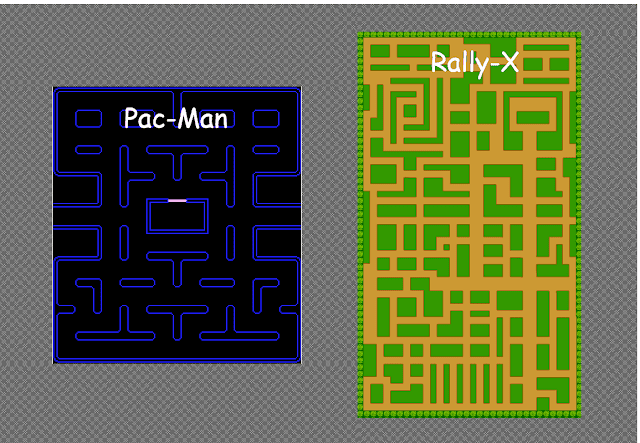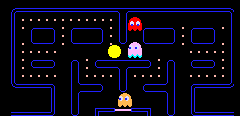Rally-X vs. Pac-Man: Double-Checking History
When Pac-Man was first demonstrated at a 1980 trade show sponsored by the Amusement Machine Operators of America, it was shown alongside a number of other video game classics, including Defender and Battlezone. Believe it or not, however, none of these games were getting as much buzz as an overhead racing game called Rally-X. You're forgiven if this name is not familiar, as its sales ended up paling in comparison to the aforementioned titles, but at the time, many industry execs thought it was the runaway king of the trade show. Boy, were they wrong.
But was Rally-X really as weak as its sales indicate, or was the public simply not appreciating its nuance? Even some modern reviewers think it was only a small step from classic status (here, for example), so I wanted to do an in-depth look at the game mechanics to see if this claim holds up. Rally-X often draws comparisons to Pac-Man, with its 2-D maze chase premise, so let's to do a side-by-side comparison.
Basic Gameplay
Rally-X and Pac-Man both challenge you to collect items in a two-dimensional maze. Enemies constantly pursue you, so you must elude them while collecting all of the items if you want to advance through each stage. Pac-Man has you eating pellets and being pursued by ghosts, while in Rally-X you collect flags while being pursued by other cars, but the basic goal is the same.
There are some differences, however. Let's look at them individually and see how they impact the gameplay.
There are some differences, however. Let's look at them individually and see how they impact the gameplay.
Layout
Survival in each game depends on the player's ability to navigate a maze. Here's a side-by-side comparison of the mazes in the two games:
That Rally-X maze is quite a beast! Compared to the Pac-Man maze, it has about 20 times the area and lacks any large-scale symmetries. But does this translate to deeper gameplay?
Well, the effects of maze size are complicated. Roughly speaking, a larger maze will be more difficult for the player to navigate and memorize, but will also give them more room to separate from their enemies. Players will quickly become familiar with the maze in Pac-Man, but you never really have the option of keeping the ghosts at a distance, at least not for long. In Rally-X, if you can keep the enemy cars far enough away, either with evasion or smoke screens, you won't have to worry as much about the nearby twists and turns of the maze. This not an easy thing to do, mind you, but at least prevents the game from being unmanageable.
I think the more important differentiating factor is not the maze size, but rather how much of it you can see at once. Whereas Pac-Man is played on a fixed view of the full maze, Rally-X only shows you about 4% of the maze at any one time.
You can track the approximate positions of the enemies using the radar on the bottom right side of the screen, but it won't show you their exact movements through the maze. If we overlay a snippet of gameplay from Rally-X on an image of the maze, we can get a sense for how this changes the experience compared to playing Pac-Man.
In Pac-Man, I can watch the ghosts move about the maze and I can anticipate their movements to form complex strategies. In Rally-X, enemies pop in and out of my field of view, depending on how close they are, and I have only a rough idea of the position of the more distant enemies (using the radar). As such, the game becomes more about maintaining distance and reacting to sudden enemy appearances.
Of course, gaining a familiarity with the Rally-X maze does help; for example, I quickly learned to avoid the dead-end cul-de-sac in the upper right corner of the map. However, there is limited value to even this level of familiarity, because boulder obstructions can randomly appear at various points in the maze.
Enemy AI
The Pac-Man AI is famously clever, with the ghosts alternating between three different modes, and each using a distinct algorithm for tracking the player. The details are well documented on the internet (see GameInternals, for example), so I won't go into them here, but suffice to say that they give the player plenty to consider, even given the relative simplicity of the Pac-Man maze. How does the Rally-X AI compare?
In the clip below, I isolated a single car and watched how it responded to my movements.
As you might expect, the enemy car tracks the player. The algorithm appears to be very simple: the car follows my turns and doesn't seem to have different modes. What's more, the Rally-X enemies are all the same; that is, they all use the same sprite and follow the player in the same way. If different cars behave differently, I saw no evidence of it.
Clearly, this is one area where Pac-Man has much more depth, but the sophistication of the AI is not by itself an objective measure of quality. In fact, a simple AI actually makes sense given the differences in the player's view of the maze -- the fact that the cars all behave the same way makes it easier to "gather" them into clumps and keep them at a distance so that you don't have to worry about their exact paths through the maze. A complex AI would have been unreasonably difficult to track without a full maze view.
In the clip below, I isolated a single car and watched how it responded to my movements.
As you might expect, the enemy car tracks the player. The algorithm appears to be very simple: the car follows my turns and doesn't seem to have different modes. What's more, the Rally-X enemies are all the same; that is, they all use the same sprite and follow the player in the same way. If different cars behave differently, I saw no evidence of it.
Clearly, this is one area where Pac-Man has much more depth, but the sophistication of the AI is not by itself an objective measure of quality. In fact, a simple AI actually makes sense given the differences in the player's view of the maze -- the fact that the cars all behave the same way makes it easier to "gather" them into clumps and keep them at a distance so that you don't have to worry about their exact paths through the maze. A complex AI would have been unreasonably difficult to track without a full maze view.
Countermeasures
Both games offer the player a means of fighting back. In Pac-Man, when you munch a power pellet, the ghosts suddenly become edible, allowing you to rack up points while continuing to clear the maze.
In Rally-X, you can't destroy (or eat) the cars, but you do have a defensive capability. At any time, you can drop a smokescreen that sends pursuing cars into a temporary tail spin. However, smokescreens use up fuel, so you will need to use them sparingly.
In Rally-X, you can't destroy (or eat) the cars, but you do have a defensive capability. At any time, you can drop a smokescreen that sends pursuing cars into a temporary tail spin. However, smokescreens use up fuel, so you will need to use them sparingly.
Whereas the Pac-Man ghost-chomping capability is an important game element that necessarily occurs four times in every stage, the smokescreen is more of an emergency tactic. You can clear entire levels without using it, and the best players will probably learn to get by using it only rarely.
Again, I think Pac-Man's approach adds more depth. Advanced Pac-Man players will develop complex strategies for gathering the ghosts together so that they can chomp as many as possible and maximize their score. And while there is undoubtedly skill involved in optimizing your smokescreen use in Rally-X, the player can't see enough of the maze to do much strategizing with it, and is actually better off learning to do without it.
Setting and Premise
Finally, what about the game worlds? Of course, neither offers the player a deep, complex backstory to consider, but then no arcade games did in 1980. Instead, they just offer hints of context.
 Rally-X gives the player an approximate real-world setting for the action, featuring a bunch of old-timey race cars moving haphazardly around a track. I doubt there are any real-world rallies where the drivers maniacally try to plow into one another, but it's sufficiently close to a real thing that the player should be able to use their imagination to fill it out.
Rally-X gives the player an approximate real-world setting for the action, featuring a bunch of old-timey race cars moving haphazardly around a track. I doubt there are any real-world rallies where the drivers maniacally try to plow into one another, but it's sufficiently close to a real thing that the player should be able to use their imagination to fill it out.
By contrast, Pac-Man's world was an original creation, a bizarre abstraction that no doubt left gamers (and marketing departments) wondering what to make of it. I expect industry execs of the time viewed this as a weakness. After all, how do you even describe Pac-Man to someone who's never played it, let alone convince them it will be fun? But I think this underestimates the appeal of simple abstractions. As I already noted in my review of Breakout, some of the most successful games ever made ask players to manipulate simple squares and cubes, so why not a chomping circle and colored ghosts?
Bottom Line
Also, we shouldn't underestimate the importance of presentation. Rally-X presents itself as a racing game, but doesn't seem devoted to any particular aesthetic. It's not realistic enough to be a true sports simulation and its not quirky enough to be surrealist. Meanwhile, Pac-Man dared to forge its own conceptual ground with a minimalist tack that captured gamers' imaginations to such an extent that Pac-Man is still one of the world's most recognizable video game characters.
Finally, Pac-Man's game mechanics are highly emergent -- from only four ghost AI algorithms and a simple maze came countless strategies. Its complexity even led hardcore gamers to formulate turn-by-turn patterns to maximize points on each level. If such patterns exist for Rally-X, they would have to be determined through blind trial and error, since the enemy movements are mostly obscured. That doesn't sound like fun.
Ultimately, I think the similarities between Rally-X and Pac-Man are overstated and I doubt that superficial changes to Rally-X would have launched it into Pac-Man's league. It is fun, and worth trying for those interested in gaming history, but not a game I would recommend most people go out of their way for.








I've long felt Rally-X was very comparable to Pac-Man, but not half as fun. This was a good analysis explaining why.
ReplyDeleteThis comment has been removed by the author.
ReplyDeleteI actually have more fun with New Rally X than Ms. Pac-Man which is my favorite of the 80s Pac-Man games. For me, I just like having more control over the countermeasure. The power pellets are stationary and you can only use them by moving to one of the corners. I like that you can use the smoke screen at any time. It's also the reason why Mouse Trap is one of my favorite arcade maze games. I just like having more control over offensive/defensive capabilities.
ReplyDelete